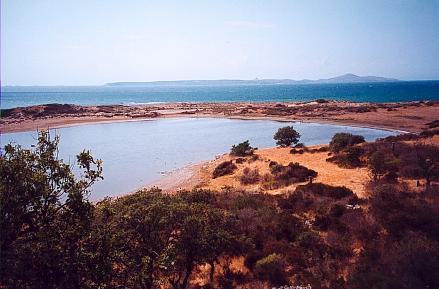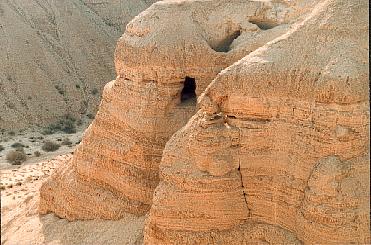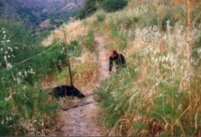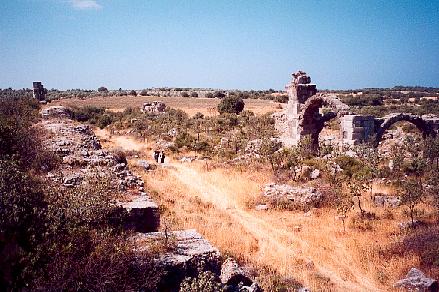


Roman Harbor at Alexandria Troas, Turkey
(Photograph by Kenneth Atkinson)
In the 1st Century A.D., Alexandria Troas was a meeting place for leaders of the early Christian Church. Luke met Paul in Troas. While in Troas, Paul had a vision telling him to preach in Europe (Acts 16:8-11; 2 Corinthians 2:12). During Paul's second stay in Alexandria Troas he revived Eutychus who had fallen out of a third floor window (Acts 20: 5-12). This harbor in this photograph has become filled with silt over the centuries. The picture is taken from inside the city where the boats docked. Paul sailed from this harbor several times as recorded in the Acts.

Qumran Cave 4: Location of the greatest collection of Dead Sea Scrolls
(Photograph by Kenneth Atkinson)
Course Description:
This course is an introduction to the history and ideas of the New Testament and other early Christian writings. The class will examine how the books of the New Testament came into being, who produced them, what they mean, and how they came to be collected into a canon of Scripture. In this course students will not only examine the New Testament, but will also read a variety of other early Christian writings that illumine the development of Christianity. Classes will also include presentations of recent unpublished archaeological and textual discoveries, from the instructor's archaeological excavations and research on the Dead Sea Scrolls, that help us to understand the world of the New Testament and early Christianity.
Course Objectives:
This course is not only an introduction to the New Testament and early Christian writings, but is also an examination of academic approaches to that literature. The lectures will examine New Testament documents within the historical context of the first two centuries A.D., highlighting their distinctive literary and religious features. No previous familiarity with the New Testament or with scriptural interpretation is expected. In this class you will read the entire New Testament in a critical fashion, focusing upon what the text actually says in light of its historical and cultural background. Some of the questions we will examine include:
In this class we will also read lost gospels hidden in the Egyptian desert that were discovered only in this century (the Nag Hammadi texts); learn about archaeological evidence of crucifixion; discover what happens during an archaeological excavation; and learn about women bishops in the first century A.D. By examining the New Testament in light of its historical and cultural background, you will not only learn how Christianity developed, but you will also gain an understanding of why people disagree, and have fought for centuries, over how the New Testament should be interpreted.
At the end of this course you should have learned a new way of critically reading the New Testament that brings to light its historical and cultural background. The primary goal of this course is to help you understand what took place during this complex period when Christianity emerged as a distinctive religion, without imposing later ideas or value judgments upon the New Testament. This course, therefore, focuses upon what the authors of the New Testament and other early Christian texts meant when they wrote these documents. In this class, we will not explore the history of New Testament interpretation or the history of Christianity, although these fields of inquiry may at times help us to understand the New Testament. The interested student may wish to follow this course with a class on the history of Judaism or Christianity, both of which will examine how later people and religious movements have interpreted the New Testament.

Feeding a Wild Boar in the Golan Heights, Israel
(Photographed near the location of the story in Mark 5:1-20.)
Forthcoming Bible Translation
I am currently involved in a forthcoming translation of the Septuagint (LXX), which is the Greek translation of the Old Testament from Hebrew and Aramaic (Alexandrian Bible). The translation, to be published by Oxford University Press, is scheduled to appear late 2005. A provisional edition of this translation, titled A New English Translation of the Septuagint (NETS), can be found by clicking here. The site also includes addidtional information about the LXX and links to other related LXX sites. The files are protected by copyright notice as described at the beginning of each book. I hope that you find this Bible interesting and compare it with your English translation of the Hebrew Scriptures.
Interesting Links:
New Testament Gateway (This page from the Web Site "New Testament Gateway" contains many links to various English translation of the Bible).
Old Testament Gateway (Similiar to New Testament Gateway.).
Biblical Archaeology Society [Biblical Archaeology Review and Bible Review Magazines. You can also find these publication in our library.]
New Testament Gateway (Best collection of links on the New Testament. You will also find a list of web blogs on the New Testament).
Orion Center for the Study of the Dead Sea Scrolls (Includes information about the Dead Sea Scrolls including a massive bibliography of the leading publications.).
Synoptic Problem (This site contains many interesting charts showing the different solutions to this problem.).
The Development of the New Testament Canon (Everything you wanted to know about how and when the New Testament canon was selected).
Ancient Christian Writings (Translations of many different early Christian texts).
Septuagint (Infornation on the Septuagint with many interesting links).
Biblical Archaeology Society (Publisher of Bible Review and Biblical Archaeology Review. Both of these magazines are in the Rod Library.).
Resources for the Mel Gibson Move, The Passion of the Christ [Look over some of these sites for historical background if you plan to see the film]
A Comparison of the Passion Narratives [Nice chart showing the differences between the New Testament accounts of the Passion]
Crucifixion in Antiquity [includes photographs of the only known remains of a crucified man]
Josephus on the death of John the Baptist
Jewish Roman World of Jesus (Many Great links)
Arts and Letters Daily (Links to the most interesting articles on the internet. In the left column, you will find links to papers and magazines representing the best of liberal and conservative thought. This site is updated daily. Take a look at some of the foreign papers for a different perspective on the news.).
Beliefnet (Religions of the World is, in my opinion, perhaps the most important course offered at UNI since learning to get along with different faiths is essential to world peace. This site contains much useful information about the many religions of the world. It also contains many articles about current religious conflicts. Go to the center of the page and click the "Religion" link.)
I am presently writing a biography of a woman queen. Here are a few interesting sites about women that I have found quite useful.
Diotima: Women and Gender in the Ancient World
Feminae Romanae: The Women of Ancient Rome

Ruins of the Roman Bath of Herodes Atticus, 2nd century A.D.
This was once among the most beautiful baths of the Roman Empire.
The entire structure was covered by a roof.
(Photograph by Kenneth Atkinson)